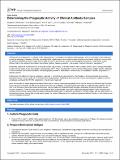Determining the Phagocytic Activity of Clinical Antibody Samples
Author(s)
McAndrew, Elizabeth G.; Dugast, Anne-Sophie; Licht, Anna F.; Eusebio, Justin R.; Alter, Galit; Ackerman, Margaret E.; ... Show more Show less
DownloadMcAndrew-2011-Determining the phag.pdf (189.7Kb)
PUBLISHER_POLICY
Publisher Policy
Article is made available in accordance with the publisher's policy and may be subject to US copyright law. Please refer to the publisher's site for terms of use.
Terms of use
Metadata
Show full item recordAbstract
Antibody-driven phagocytosis is induced via the engagement of Fc receptors on professional phagocytes, and can contribute to both clearance as well as pathology of disease. While the properties of the variable domains of antibodies have long been considered critical to in vivo function, the ability of antibodies to recruit innate immune cells via their Fc domains has become increasingly appreciated as a major factor in their efficacy, both in the setting of recombinant monoclonal antibody therapy, as well as in the course of natural infection or vaccination1-3.
Importantly, despite its nomenclature as a constant domain, the antibody Fc domain does not have constant function, and is strongly modulated by IgG subclass (IgG1-4) and glycosylation at Asparagine 2974-6. Thus, this method to study functional differences of antigen-specific antibodies in clinical samples will facilitate correlation of the phagocytic potential of antibodies to disease state, susceptibility to infection, progression, or clinical outcome.
Furthermore, this effector function is particularly important in light of the documented ability of antibodies to enhance infection by providing pathogens access into host cells via Fc receptor-driven phagocytosis7. Additionally, there is some evidence that phagocytic uptake of immune complexes can impact the Th1/Th2 polarization of the immune response8.
Here, we describe an assay designed to detect differences in antibody-induced phagocytosis, which may be caused by differential IgG subclass, glycan structure at Asn297, as well as the ability to form immune complexes of antigen-specific antibodies in a high-throughput fashion. To this end, 1 μm fluorescent beads are coated with antigen, then incubated with clinical antibody samples, generating fluorescent antigen specific immune complexes. These antibody-opsonized beads are then incubated with a monocytic cell line expressing multiple FcγRs, including both inhibitory and activating. Assay output can include phagocytic activity, cytokine secretion, and patterns of FcγRs usage, and are determined in a standardized manner, making this a highly useful system for parsing differences in this antibody-dependent effector function in both infection and vaccine-mediated protection9.
Date issued
2011-11Department
Massachusetts Institute of Technology. Department of Biology; Ragon Institute of MGH, MIT and HarvardJournal
Journal of Visualized Experiments
Publisher
MyJoVE Corporation
Citation
McAndrew, Elizabeth G., Anne-Sophie Dugast, Anna F. Licht, Justin R. Eusebio, Galit Alter, and Margaret E. Ackerman. “Determining the Phagocytic Activity of Clinical Antibody Samples.” JoVE no. 57 (2011).
Version: Final published version
ISSN
1940-087X